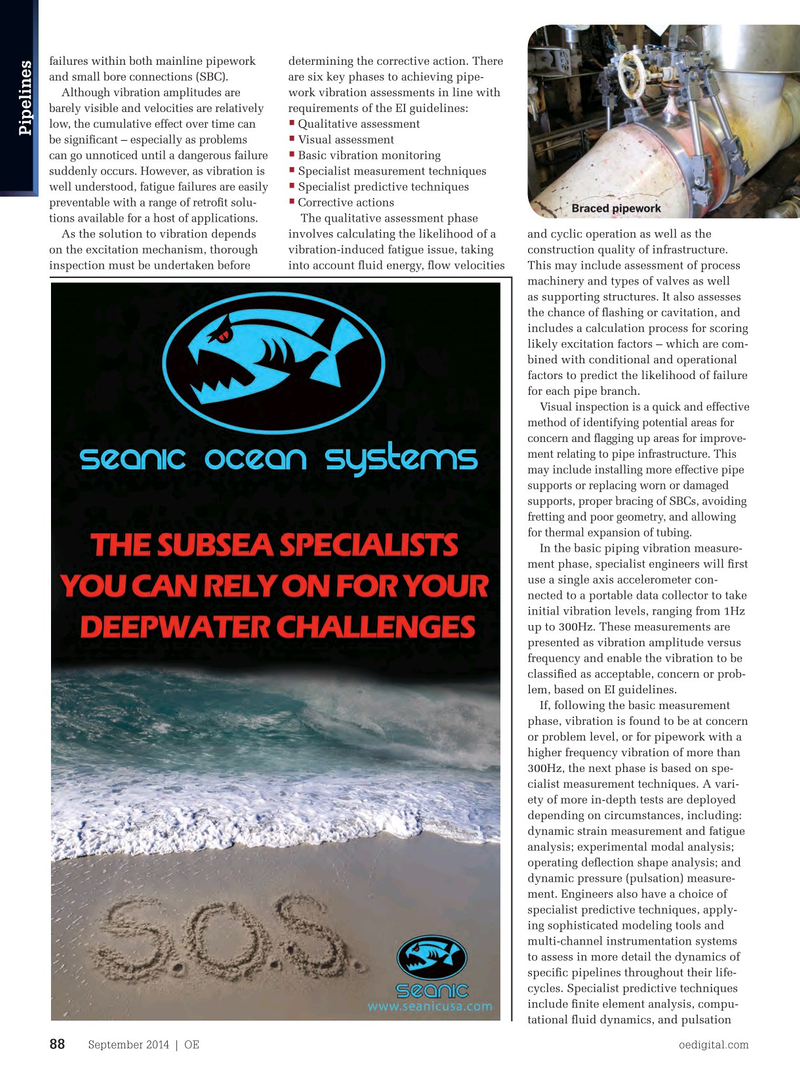
Page 86: of Offshore Engineer Magazine (Sep/Oct 2014)
Read this page in Pdf, Flash or Html5 edition of Sep/Oct 2014 Offshore Engineer Magazine
failures within both mainline pipework determining the corrective action. There and small bore connections (SBC). are six key phases to achieving pipe-
Although vibration amplitudes are work vibration assessments in line with barely visible and velocities are relatively requirements of the EI guidelines: • Qualitative assessment low, the cumulative effect over time can
Pipelines • Visual assessment be signifcant – especially as problems • Basic vibration monitoring can go unnoticed until a dangerous failure • Specialist measurement techniques suddenly occurs. However, as vibration is • Specialist predictive techniques well understood, fatigue failures are easily • Corrective actions preventable with a range of retroft solu-
Braced pipework
The qualitative assessment phase tions available for a host of applications.
As the solution to vibration depends involves calculating the likelihood of a and cyclic operation as well as the on the excitation mechanism, thorough vibration-induced fatigue issue, taking construction quality of infrastructure.
Visco-elastic damper inspection must be undertaken before into account fuid energy, fow velocities This may include assessment of process machinery and types of valves as well as supporting structures. It also assesses the chance of fashing or cavitation, and includes a calculation process for scoring likely excitation factors – which are com- bined with conditional and operational factors to predict the likelihood of failure for each pipe branch.
Visual inspection is a quick and effective method of identifying potential areas for concern and fagging up areas for improve- ment relating to pipe infrastructure. This may include installing more effective pipe supports or replacing worn or damaged supports, proper bracing of SBCs, avoiding fretting and poor geometry, and allowing for thermal expansion of tubing.
In the basic piping vibration measure- ment phase, specialist engineers will frst use a single axis accelerometer con- nected to a portable data collector to take initial vibration levels, ranging from 1Hz up to 300Hz. These measurements are presented as vibration amplitude versus frequency and enable the vibration to be classifed as acceptable, concern or prob- lem, based on EI guidelines.
If, following the basic measurement phase, vibration is found to be at concern or problem level, or for pipework with a higher frequency vibration of more than 300Hz, the next phase is based on spe- cialist measurement techniques. A vari- ety of more in-depth tests are deployed depending on circumstances, including: dynamic strain measurement and fatigue analysis; experimental modal analysis; operating defection shape analysis; and dynamic pressure (pulsation) measure- ment. Engineers also have a choice of specialist predictive techniques, apply- ing sophisticated modeling tools and multi-channel instrumentation systems to assess in more detail the dynamics of specifc pipelines throughout their life- cycles. Specialist predictive techniques include fnite element analysis, compu- tational fuid dynamics, and pulsation
September 2014 | OE oedigital.com 88 086_0914_Pipelines2_AVT.indd 88 8/21/14 8:04 PM

 85
85

 87
87